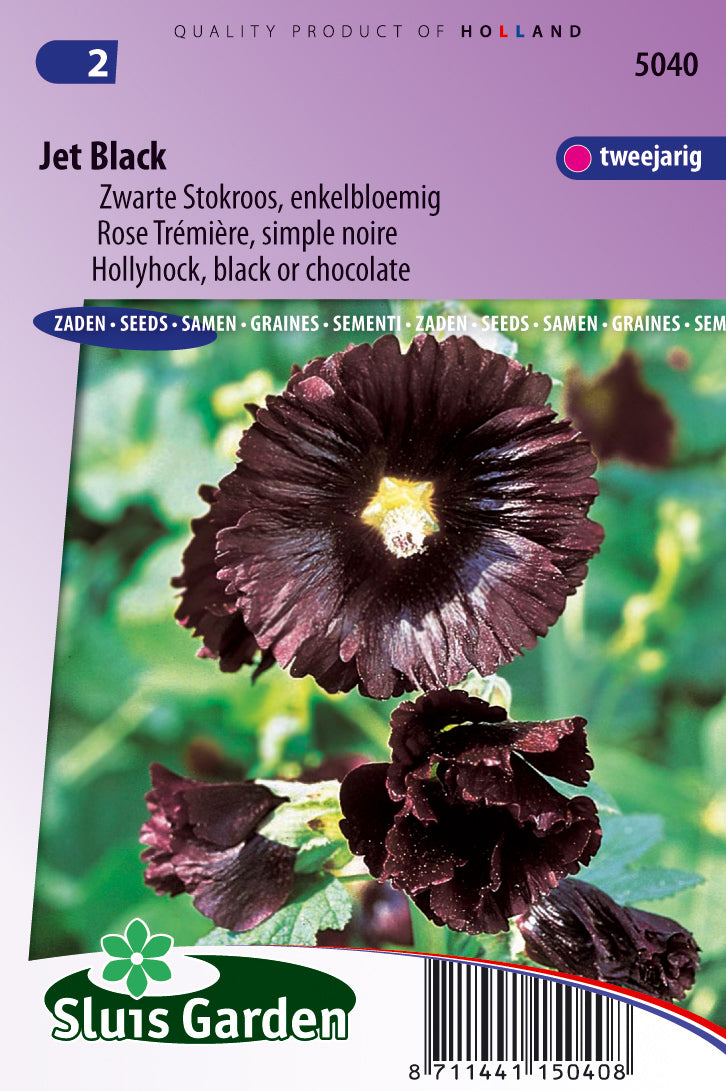1
/
of
1
Alcea Rosea Nigra Jet Black
Alcea Rosea Nigra Jet Black
Regular price
1.350 KWD
Regular price
Sale price
1.350 KWD
Unit price
/
per
Shipping calculated at checkout.
Couldn't load pickup availability
Alcea rosea 'Nigra,' commonly known as Jet Black Hollyhock, is a striking perennial known for its deep, dark purple to almost black flowers. Here's a guide on how to grow Alcea rosea 'Nigra' Jet Black:
**1. Planting Time:**
- Hollyhocks can be started from seeds or purchased as young plants. If starting from seeds, sow them indoors 6-8 weeks before the last expected frost or directly outdoors in the spring. Ensure the last frost date has passed before planting.
**2. Soil Preparation:**
- Choose a well-draining, fertile soil for your Hollyhocks. Amend the soil with organic matter, such as compost, to improve fertility and drainage.
**3. Sunlight:**
- Hollyhocks prefer full sunlight. Choose a location in your garden that receives at least 6-8 hours of direct sunlight daily.
**4. Planting Seeds or Transplanting:**
- **Seeds:** Sow Hollyhock seeds on the soil surface and lightly press them into the soil. Water the area well after planting. The seeds need light for germination.
- **Transplants:** If starting from young plants, transplant them into well-prepared soil at the same depth they were growing in their containers.
**5. Spacing:**
- Space the seeds or transplants about 18 to 24 inches apart to allow for proper air circulation and prevent overcrowding.
**6. Watering:**
- Keep the soil consistently moist, especially during dry periods. Water at the base of the plants to avoid wetting the foliage.
**7. Mulching:**
- Apply a layer of organic mulch, such as straw or shredded leaves, around the base of the plants to retain soil moisture and suppress weeds.
**8. Support:**
- Hollyhocks can grow tall and may require staking to support their flower spikes. Install stakes early in the growing season to prevent damage to the plants.
**9. Fertilization:**
- Hollyhocks generally do well in moderately fertile soil. If needed, you can incorporate a balanced organic fertilizer into the soil before planting.
**10. Companion Planting:**
- Hollyhocks can be planted with other sun-loving flowers and can create a beautiful backdrop in a mixed flower border.
**11. Deadheading:**
- Deadhead spent flowers regularly to encourage continuous blooming and prevent self-seeding if you want to control their spread.
**12. Disease and Pest Control:**
- Hollyhocks are susceptible to rust disease. Planting in a location with good air circulation and proper spacing can help minimize this issue. Neem oil can be used as an organic solution for rust.
**13. Perennial Care:**
- Hollyhocks are generally short-lived perennials, but they can self-seed and return in subsequent years. Allow some flowers to produce seeds if you want them to come back.
**14. Organic Certification:**
- If you wish to officially label your Alcea rosea 'Nigra' Jet Black as organic, follow the guidelines and requirements set by your local organic certification body.
Growing Alcea rosea 'Nigra' Jet Black can add a dramatic touch to your garden with its dark, almost black, flowers. Following organic practices ensures a healthy and sustainable growing environment for your plants.
**1. Planting Time:**
- Hollyhocks can be started from seeds or purchased as young plants. If starting from seeds, sow them indoors 6-8 weeks before the last expected frost or directly outdoors in the spring. Ensure the last frost date has passed before planting.
**2. Soil Preparation:**
- Choose a well-draining, fertile soil for your Hollyhocks. Amend the soil with organic matter, such as compost, to improve fertility and drainage.
**3. Sunlight:**
- Hollyhocks prefer full sunlight. Choose a location in your garden that receives at least 6-8 hours of direct sunlight daily.
**4. Planting Seeds or Transplanting:**
- **Seeds:** Sow Hollyhock seeds on the soil surface and lightly press them into the soil. Water the area well after planting. The seeds need light for germination.
- **Transplants:** If starting from young plants, transplant them into well-prepared soil at the same depth they were growing in their containers.
**5. Spacing:**
- Space the seeds or transplants about 18 to 24 inches apart to allow for proper air circulation and prevent overcrowding.
**6. Watering:**
- Keep the soil consistently moist, especially during dry periods. Water at the base of the plants to avoid wetting the foliage.
**7. Mulching:**
- Apply a layer of organic mulch, such as straw or shredded leaves, around the base of the plants to retain soil moisture and suppress weeds.
**8. Support:**
- Hollyhocks can grow tall and may require staking to support their flower spikes. Install stakes early in the growing season to prevent damage to the plants.
**9. Fertilization:**
- Hollyhocks generally do well in moderately fertile soil. If needed, you can incorporate a balanced organic fertilizer into the soil before planting.
**10. Companion Planting:**
- Hollyhocks can be planted with other sun-loving flowers and can create a beautiful backdrop in a mixed flower border.
**11. Deadheading:**
- Deadhead spent flowers regularly to encourage continuous blooming and prevent self-seeding if you want to control their spread.
**12. Disease and Pest Control:**
- Hollyhocks are susceptible to rust disease. Planting in a location with good air circulation and proper spacing can help minimize this issue. Neem oil can be used as an organic solution for rust.
**13. Perennial Care:**
- Hollyhocks are generally short-lived perennials, but they can self-seed and return in subsequent years. Allow some flowers to produce seeds if you want them to come back.
**14. Organic Certification:**
- If you wish to officially label your Alcea rosea 'Nigra' Jet Black as organic, follow the guidelines and requirements set by your local organic certification body.
Growing Alcea rosea 'Nigra' Jet Black can add a dramatic touch to your garden with its dark, almost black, flowers. Following organic practices ensures a healthy and sustainable growing environment for your plants.
Share

